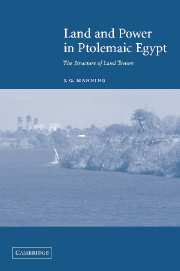Book contents
- Frontmatter
- Contents
- List of maps, figures and tables
- Preface
- Abbreviations
- Units of measure
- Maps
- Part I ISSUES AND HISTORICAL BACKGROUND
- Part II REGIONAL CASE STUDIES OF LAND TENURE
- Chapter 3 The land tenure regime in Upper Egypt
- Chapter 4 The land tenure regime in the Fayyum depression
- Part III INTERPRETATION
- Appendix 1 Translation of the Edfu donation text
- Appendix 2 Ptolemaic demotic land transfers from Upper Egypt
- Appendix 3 Translation of P. Amh. gr. 49
- List of references
- Index of sources
- General index
Chapter 4 - The land tenure regime in the Fayyum depression
Published online by Cambridge University Press: 22 September 2009
- Frontmatter
- Contents
- List of maps, figures and tables
- Preface
- Abbreviations
- Units of measure
- Maps
- Part I ISSUES AND HISTORICAL BACKGROUND
- Part II REGIONAL CASE STUDIES OF LAND TENURE
- Chapter 3 The land tenure regime in Upper Egypt
- Chapter 4 The land tenure regime in the Fayyum depression
- Part III INTERPRETATION
- Appendix 1 Translation of the Edfu donation text
- Appendix 2 Ptolemaic demotic land transfers from Upper Egypt
- Appendix 3 Translation of P. Amh. gr. 49
- List of references
- Index of sources
- General index
Summary
Sailing along shore for a distance of one hundred stadia, one comes to the city of Arsinoê, which in earlier times was called Krocodeilonopolis; for the people in this Nome hold in very great honour the crocodile, and there is a sacred one there which is kept and fed by itself in a lake, and is tame to the priests.
Strabo, Geography, 17.1.38… the successful reclamation of new land would not only enable the king to reward and settle troops – an important consideration in a world where fighting men were in heavy demand – but would also increase the long-term yield of his kingdom. So there were compelling reasons behind the development of the Fayyum under the first three Ptolemies.
Thompson 1999a: 109.THE PRE-PTOLEMAIC FAYYUM
The Fayyum is a natural depression, or, more technically, a “deflation hollow,” formed by wind erosion and located some sixty miles southwest of the ancient Egyptian capital of Memphis. The region was fed with water by the Bahr Yusef, “Joseph's Canal,” as the Copts called it, which runs parallel to the Nile river from around Asyut, through the Lahun gap. A lake, formed originally by a much higher Nile level, was fed by the Bahr Yusef. Determining its level in antiquity is an important, if not yet settled, aspect of assessing the agricultural potential of this region in antiquity. Irrigation in the area was fed by gravity, as it still is today.
- Type
- Chapter
- Information
- Land and Power in Ptolemaic EgyptThe Structure of Land Tenure, pp. 99 - 126Publisher: Cambridge University PressPrint publication year: 2003



